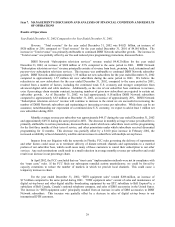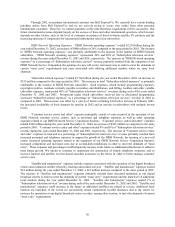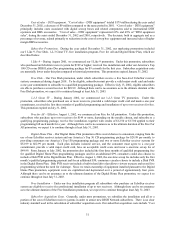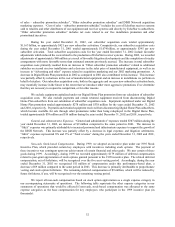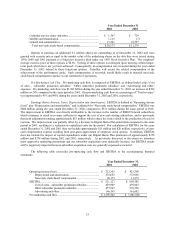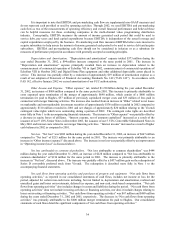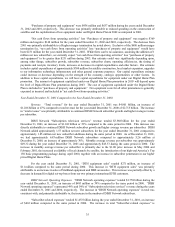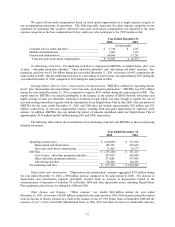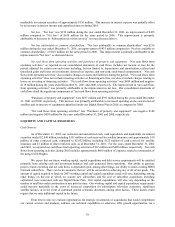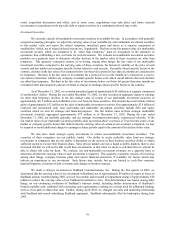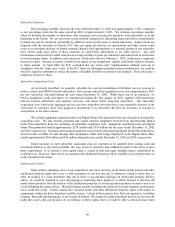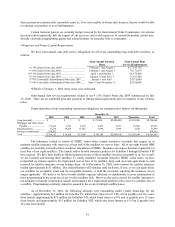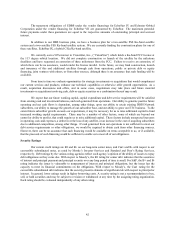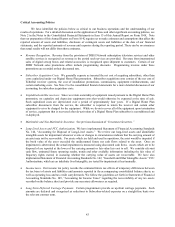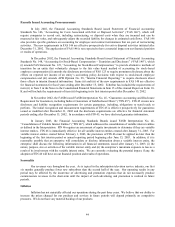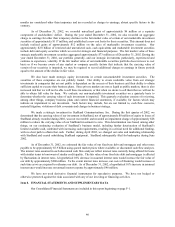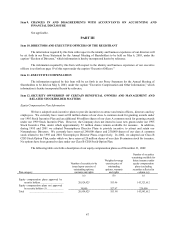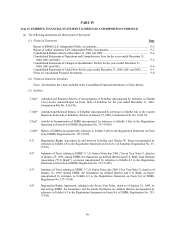Dish Network 2002 Annual Report Download - page 41
Download and view the complete annual report
Please find page 41 of the 2002 Dish Network annual report below. You can navigate through the pages in the report by either clicking on the pages listed below, or by using the keyword search tool below to find specific information within the annual report.39
result, acquisition discussions and offers, and in some cases, negotiations may take place and future material
investments or acquisitions involving cash, debt or equity securities or a combination thereof may result.
Investment Securities
We currently classify all marketable investment securities as available-for-sale. In accordance with generally
accepted accounting principles, we adjust the carrying value of our available-for-sale marketable investment securities
to fair market value and report the related temporary unrealized gains and losses as a separate component of
stockholders’ deficit, net of related deferred income tax, if applicable. Declines in the fair market value of a marketable
investment security which are estimated to be “other than temporary” must be recognized in the statement of
operations, thus establishing a new cost basis for such investment. We evaluate our marketable investment securities
portfolio on a quarterly basis to determine whether declines in the market value of these securities are other than
temporary. This quarterly evaluation consists of reviewing, among other things, the fair value of our marketable
investment securities compared to the carrying value of these securities, the historical volatility of the price of each
security and any market and company specific factors related to each security. Generally, absent specific factors to the
contrary, declines in the fair value of investments below cost basis for a period of less than six months are considered to
be temporary. Declines in the fair value of investments for a period of six to nine months are evaluated on a case by
case basis to determine whether any company or market-specific factors exist which would indicate that such declines
are other than temporary. Declines in the fair value of investments below cost basis for greater than nine months are
considered other than temporary and are recorded as charges to earnings, absent specific factors to the contrary.
As of December 31, 2002, we recorded unrealized gains of approximately $6 million as a separate component
of stockholders’ deficit. During the year ended December 31, 2002, we also recorded an aggregate charge to earnings
for other than temporary declines in the fair market value of certain of our marketable investment securities of
approximately $117 million and established a new cost basis for these securities. This amount does not include realized
gains of approximately $12 million on the sales of marketable investment securities. Our approximately $2.8 billion of
restricted and unrestricted cash, cash equivalents and marketable investment securities include debt and equity
securities which we own for strategic and financial purposes. The fair market value of these strategic marketable
investment securities aggregated approximately $73 million as of December 31, 2002. During the year ended
December 31, 2002, our portfolio generally, and our strategic investments particularly, experienced volatility. If the
fair market value of our marketable securities portfolio does not remain above cost basis or if we become aware of any
market or company specific factors that indicate that the carrying value of certain of our securities is impaired, we may
be required to record additional charges to earnings in future periods equal to the amount of the decline in fair value.
We also have made strategic equity investments in certain non-marketable investment securities. The
securities of these companies are not publicly traded. Our ability to create realizable value from our strategic
investments in companies that are not public is dependent on the success of their business and their ability to obtain
sufficient capital to execute their business plans. Since private markets are not as liquid as public markets, there is also
increased risk that we will not be able to sell these investments, or that when we desire to sell them that we will not be
able to obtain full value for them. We evaluate our non-marketable investment securities on a quarterly basis to
determine whether the carrying value of each investment is impaired. This quarterly evaluation consists of reviewing,
among other things, company business plans and current financial statements, if available, for factors which may
indicate an impairment in our investment. Such factors may include, but are not limited to, cash flow concerns,
material litigation, violations of debt covenants and changes in business strategy.
We made a strategic investment in StarBand Communications, Inc. During the first quarter of 2002, we
determined that the carrying value of our investment in StarBand, net of approximately $8 million of equity in losses of
StarBand already recorded during 2002, was not recoverable and recorded an impairment charge of approximately $28
million to reduce the carrying value of our StarBand investment to zero. This determination was based, among other
things, on our continuing evaluation of StarBand’s business model, including further deterioration of StarBand’s
limited available cash, combined with increasing cash requirements, resulting in a critical need for additional funding,
with no clear path to obtain that cash. Further, during April 2002, we changed our sales and marketing relationship
with StarBand and ceased subsidizing StarBand equipment. StarBand subsequently filed for bankruptcy during June
2002.


